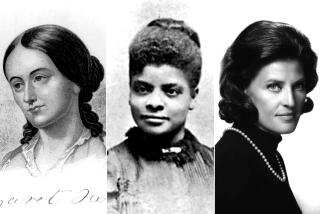Celebrated in Life, Anonymous in Death
- Share via
RHINEBECK, N.Y. — The solitary end that befell Lorena Hickok in no way reflected her life as a pioneering reporter, noted author, Depression-era New Dealer or confidant of Eleanor Roosevelt.
Her funeral rites in 1968 were witnessed only by an undertaker. Her ashes sat unclaimed on a shelf for two decades before being buried in an unmarked grave.
That’s changing. Several women are seeking to ensure Hickok’s place in history with a plaque on her grave and a shade tree she wanted. They also plan to endow a scholarship in Hickok’s name.
“I could not believe that no one picked up her ashes--somebody that had made this many contributions,” said Linda Boyd Kavars, who is spearheading the effort.
Kavars is raising money to mark the grave and start a Hickok scholarship for female students at Hudson Valley colleges. Women’s studies programs at Marist College and the state university at New Paltz plan to participate.
Hickok was born in Troy, Wis., in 1893. She became a reporter when it was almost exclusively a man’s domain. Hick, as friends called her, fit right in-- smoking cigars and playing poker while cultivating a reputation as a fine writer covering news for the Associated Press in New York City.
Her name was attached to such highly visible stories as the survivors of a 1928 shipwreck--the AP story landed on the front page of the New York Times--and the 1932 Lindbergh baby kidnapping.
In 1932 she was sent to cover Eleanor Roosevelt, whose husband was running for president. They hit it off and grew to be close friends, so close that Hickok felt she could no longer objectively report on the Roosevelts.
In 1933, just months after Franklin D. Roosevelt’s presidential inauguration, Hickok abandoned her reporting career to write field reports for the administration from the front lines of the Depression. Her flair for prose didn’t abandon her.
“A Promised Land, bathed in golden sunlight, is rising out of the gray shadows of want and squalor and wretchedness down here in the Tennessee Valley these days,” she wrote in a report to FDR aide Harry Hopkins.
She lived in the White House during World War II, and her influence on Eleanor Roosevelt soon became apparent.
She is credited with nudging the new first lady into activism and giving her the idea for her daily newspaper column, My Day. It was also her suggestion that Roosevelt hold weekly news conferences that only female reporters could attend, giving more women entry into the field.
She later followed the widowed Roosevelt to Hyde Park, N.Y., the quaint Hudson Valley town that was home to the first family’s riverside estate and now the Roosevelt Library and Museum.
Some historians imply a sexual relationship between the two women: Roosevelt expressed in her correspondences her longing to hug Hickok, who wrote in turn of wanting to kiss her friend.
However, Doris Kearns Goodwin, in her Pulitzer Prize-winning account of the Roosevelt White House, “No Ordinary Time,” quotes a friend of Eleanor Roosevelt and a former Roosevelt Library director who both doubted any physically intimate relationship existed. The pair believe Roosevelt saw Hickok as someone to whom she could reveal her emotions.
When Roosevelt died in 1962, a distraught and ailing Hickok was absent from the funeral. Instead, a minister drove her close to the cemetery near midnight so she could say goodbye in private.
Hickok, in her later years the author of such books as “The Story of Helen Keller” and “The Story of Eleanor Roosevelt,” died on May 1, 1968. No friends claimed her ashes, and they eventually were buried alongside other unclaimed remains at Rhinebeck Cemetery.
That might have been the end of Hickok’s story if not for Patsy Costello, who worked at the Hyde Park drugstore where Hickok used to buy her newspaper. In 1998 she was inspired to find Hickok’s grave after seeing a play produced by Kavars called “Lorena Hickok and Eleanor Roosevelt: A Love Story.”
“I thought it was a shame that she would be buried in an unmarked grave,” said Costello, who contacted Kavars.
The marker, which will be dedicated May 1, will call her an “author, AP reporter, activist, change agent and friend of Eleanor Roosevelt.”
More to Read
Sign up for Essential California
The most important California stories and recommendations in your inbox every morning.
You may occasionally receive promotional content from the Los Angeles Times.













